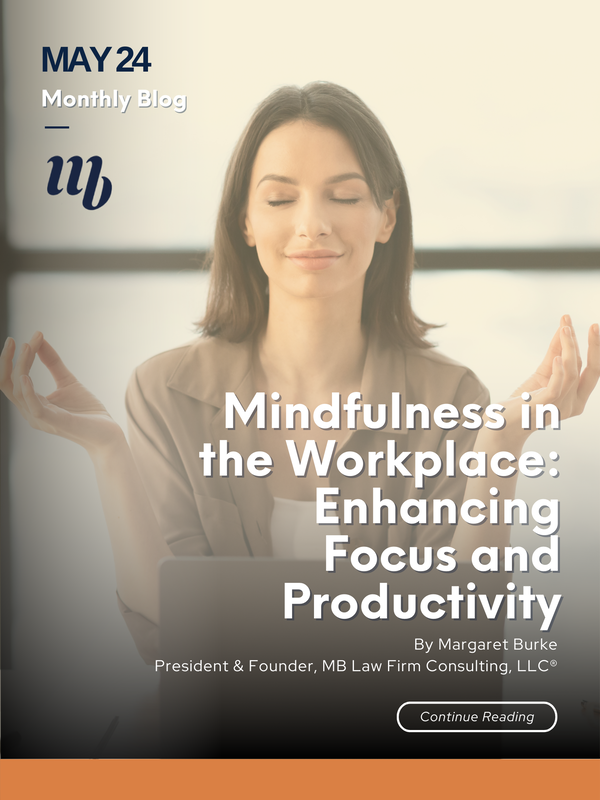
Let’s begin this article by highlighting what is not mindfulness. The opposite of mindfulness is thoughtlessness, a lack of awareness, presence, and intentionality in one’s thoughts, actions, and experiences. It is feeling consumed by numerous thoughts, unable to remain present in the moment. A lack of mindfulness decreases our creativity and problem-solving capacity, leads to procrastination, difficulty prioritizing tasks, and increased stress.
In most law firms, high pressure is part of the day-to-day environment, attorneys often face demanding workloads, tight deadlines, and complex legal challenges, the need to focus on the present moment is imperative. The importance of relaxation and stress management cannot be underestimated in such an intense atmosphere. Implementing mindfulness practices can have a significant positive impact in law-firms and across all types of companies.
Let’s revisit our opening question, if you paused and thought this may apply to you, you may benefit from practicing mindfulness techniques.
Let’s explore five practical ways to apply mindfulness techniques in the workplace. By incorporating mindfulness into our routine, we can enhance focus and productivity. Most importantly, embracing mindfulness enables us to fully engage with the present moment and be our best selves.
As a Law Firm Consultant, I’ve had the opportunity to apply these techniques in my daily routine and within Law Firms; as a result, the work environment has become more fluid and positive.
- Workspaces tools. Several project management tools incorporate features designed to promote mindfulness and reduce stress. By incorporating project management tools into our daily routines, we can have more structure and support to manage tasks effectively, reduce stress, and feel more productive. Examples of these tools include Asana, Monday.com (our tool of choice), Trello, Microsoft Workspaces, Basecamp, and others.
- The Pomodoro® Technique. This technique is a time management method developed by Francesco Cirillo. It is a structured method made up of processes, tools, principles, and values to learn how to manage time and turn it from a vicious predator to an ally to boost productivity. The Pomodoro Technique involves selecting a task and setting a timer for 25 minutes. You then work diligently on the task until the timer rings, at which point, you take a short break (ideally around 5 minutes). After completing four Pomodoros (work intervals), you then take a longer break. This method is just one example of many time management tools available; the goal is to cultivate the discipline needed to maintain focus and productivity.
- Mindful Communication. Practice mindful communication during meetings and interactions with colleagues. Listen actively without interrupting, and pause before responding to ensure your words are the right message you want to communicate to your audience. This practice fosters better understanding, empathy, and collaboration in the workplace and avoids misunderstandings and stress.
- Minimal Desk. Start by removing unnecessary items from your desk. Keep only the essentials such as your computer, keyboard, mouse, and a few pens. Store other items like paperwork, office supplies, and personal belongings in drawers or organizers and always keep your desk surface clear. Take a few minutes at the end of each day to clear your desk of any stray items and wipe down surfaces to keep them clean. Add your personal decoration, incorporating simple items like a small plant or a picture frame. Creating a minimal desk setup promotes focus, productivity, and a clutter-free work environment.
- Mindful Reflection. At the end of the day, take a few minutes to analyze your thoughts and emotions to better understand yourself. Without any judgment, reflect on your accomplishments and challenges. This activity can help you gain perspective and set intentions for the next day. Mindful reflection provides a space for introspection, allowing you to gain clarity and insight into complex situations or problems. By stepping back and viewing situations from a broader perspective, you can identify new perspectives and solutions.
In addition to these techniques consider watching “Search Inside Yourself | Chade-Meng Tan | Talks at Google”. Chade-Meng’s presentation offers a comprehensive approach to self-improvement, integrating mindfulness, emotional intelligence, and leadership development.
Let’s remember the power of being fully present in each moment. In a world filled with distractions and demands, mindfulness allows us to reflect and dive into ourselves. Embrace mindfulness at work and allow each breath, each step, and each task to be an opportunity to experience the richness of the present moment.
Let’s prioritize living in the now!
